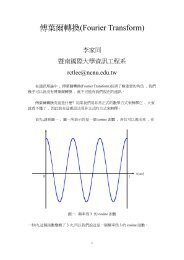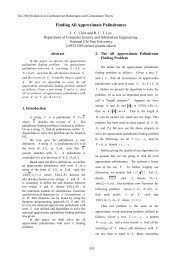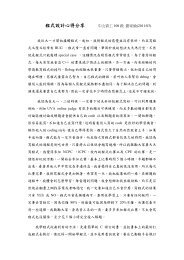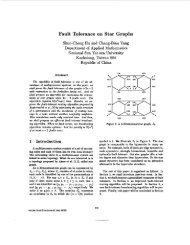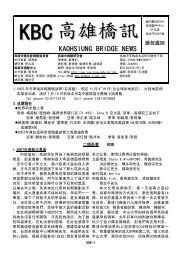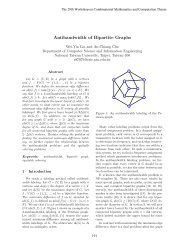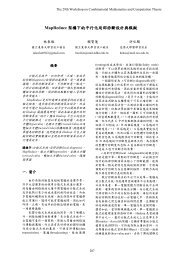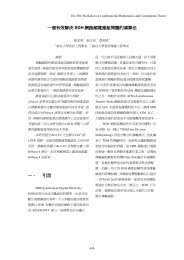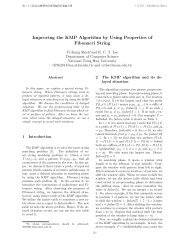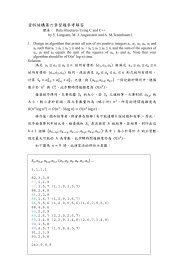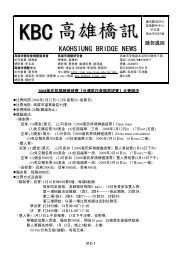The 24th Workshop on Combinatorial Mathematics and Computation TheoryW1,8W1,81321W 1,8132 11221535122112411241Figure 1: <strong>Node</strong> ranking labelings on undirected and strong orientations <strong>of</strong> W1,8.2 Main resultsLemma 1: [2] The node ranking number <strong>of</strong> a cycleCnis r( Cn) lgn 1.Since the only strong orientation <strong>of</strong> a cycle iseither a clockwise or counterclockwise directed cycle,by lemma 1, theorem 2 comes trivial.Lemma 2: Let G Cnbe a cycle on n vertices.Then the upper and lower node ranking numberRANK( G) rank( G) lgn 1.Given H be a subgraph <strong>of</strong> G, since every u-v path inH must be a u-v path in G, but not the reverse, wehave following proposition:Proposition 1: Let H be a subgraph <strong>of</strong> G. Then ( H ) ( G).rrSimilar to the undirected graph, digraphs have thesame proposition which is stated as proposition 2.Proposition 2: Let H be a subgraph <strong>of</strong> D. Then( H ) ( D).rrLemma 3: The node ranking number <strong>of</strong> a wheelW1,nis r( W1,n) lgn 2.Pro<strong>of</strong>Let vcdenote the center vertex <strong>of</strong> W1,nandV { v , v ,..., v } denote the vertices on the cycle <strong>of</strong>n1 2nthe wheel. To see that r( W1,n) lgn 2,suppose to the contrary, r( W1,n) lgn 1. LetC: V( W1,n) 1,2, , lgn1be an optimal noderanking labeling <strong>of</strong> W1,n. Since v cis adjacent tovifor all v i V n, we have Cv (c) Cv (i),vi Vn.Since every pair <strong>of</strong> vertices v , v withijCv (i) Cv (j), vi-vc-v jis a path in W 1,n, withoutloss <strong>of</strong> generality, we may have Cv (c) lgn1which implies Cv (i) lgn for all vi Vn.Consider the subgraph Cn W1,n vc, letC : V( Cn) 1,2, , lgnbe a labeling definedas C( vi) C( vi)for all v i V n. Then C is anode ranking labeling <strong>of</strong> C nwith maximum ranklg n , which implies r( Cn) lgn contradictsto Lemma 1. Hence r( W1,n) lgn 2. Nowconsider a labeling f : V( W1,n) 1,2, lgn2 which labels Vn { v1, v2,..., vn} by an optimalnode ranking labeling <strong>of</strong> C and labels the vertexvcas lg n 2 . Then f is a node ranking labeling<strong>of</strong> W1,nwith maximum rank lg n 2 whichimplies r( W1,n) lgn 2. Hence we haver( W1,n) lgn 2. Since each directed path P in a strong orientation D<strong>of</strong> graph G is a path in G, if f is an optimal noderanking <strong>of</strong> D then f must be a node ranking labeling<strong>of</strong> G. Hence we have proposition 3 as follows.Proposition 3: Let G be a graph and D be anorientation <strong>of</strong> G. Then ( D) ( G).Since the adjacent vertices may not have the samerank, lemma 4 is trivial.Lemma 4: The node ranking number <strong>of</strong> completegraph is r( Kn) n . For any tournament D withn vertices, r( D) n .Lemma 5: [8] Le G be a graphC: V( G) {1,2, k}be an optimal node rankinglabeling <strong>of</strong> G . Then i,1i k , there is a vertexv V( G)such that Cv () i.rnr-423-
The 24th Workshop on Combinatorial Mathematics and Computation TheoryTheorem 1 Let G W1,nbe a wheel graph.Then RANK( G) lgn 2.Pro<strong>of</strong> Similar to Lemma 3, let v cdenote thecenter vertex <strong>of</strong> G and Vn { v1, v2,..., vn} denote thesuburb vertices which form a cycle on the wheel.By lemma 3 and proposition 3, we haveRANK( G) lgn 2. Consider an orientation D<strong>of</strong> G which makes Vn { v1, v2,..., vn}to be adirected cycle and let v chave both out-neighborsand in-neighbors, then D is a strong orientation <strong>of</strong> G.Consider the same labeling f as in lemma 3 on D, it isa node ranking labeling <strong>of</strong> D with maximum ranklg n 2 which implies r( D) lgn 2. Bylemma 2 and lemma 5, since Vn[ D ] is a directedcycle which has at least lg n 1ranks and v cisadjacent with v ifor all v i V n, for any directednode ranking labeling C <strong>of</strong> D, we must haveC( v ) C( v ), v V , which implies C mustc i i nhave at least lg n 2 ranks. Then we haveRANK( G) r( D) lgn 2. Hence,RANK( G) lgn 2. Theorem 2 Let G W1,nbe a wheel graph.Then3 if n is even,rank( G) 4 if n is odd.Pro<strong>of</strong>: For even n, consider an orientation D1<strong>of</strong>G such that viis adjacent to vi1,vi 1where i isodd, 1 i n. vjis adjacent to v cfor all evenj, 2 j n, and vcis adjacent to vifor all odd i,1 i n. Then D1is a strong orientation <strong>of</strong> G.Consider a labeling C which ranks Cv (c) 3 ,Cv (i) 1 for all vi Vn, i is odd; andCv (j) 2 for all v j V n, j is even. Then C isa directed node ranking labeling <strong>of</strong> D1withmaximum rank 3, which impliesrank( G) r( D1) 3. Since G contains K3as asubgraph, by lemma 4 and proposition 2, wehave rank( G) r( K3) 3 which give usrank( G) 3 for even n.For odd n, consider an orientation D 2<strong>of</strong> G suchthat viis adjacent to v i1and vi 1where i isodd and 1 i n. vjis adjacent to v cfor alleven j, 2 j n , and v cis adjacent to v ifor allodd i, 1 i n, and the edge vv1 nmay be orientedeither way. Then D2is a strong orientation <strong>of</strong> G.Consider a labeling C which ranks Cv (c) 4Cv (n) 3 , Cv (i) 1 for all v i V n, i n andi is odd; and Cv (j) 2 for all v j V n, j iseven. Then C is a node ranking labeling <strong>of</strong> D 2with maximum rank 4, which impliesrank( G) r( D2) 4. Since V nis odd, and theadjacent vertices can not have the same rank, thereare at least 3 ranks have to be used in V n. SinceVccan not have the same rank with any vertex inVn, a directed node ranking labeling <strong>of</strong> anyorientation <strong>of</strong> G, must use at least 4 ranks. Then wehave rank( G) 4, hence rank( G) 4. 3 ConclusionThe node ranking problem <strong>of</strong> graphs may beextended to digraphs. This paper defined thedirected node ranking number and established bothupper and lower node ranking number <strong>of</strong> wheelgraphs among all strong orientations.References[1] H.L. Bodlaender, J.R. Gilbert, H.Hafsteninsson and T. Kloks, “Approximatingtreewidth, pathwidth, frontsize and shortestelimination tree,” Journal <strong>of</strong> Algorithms 18, pp.238-255, 1995.[2] E. Bruoth and M. Horák, “<strong>On</strong>-line rankingnumber for cycles and paths,” DiscussionesMathematicae, Graph Theory 19, pp. 175-197,1999.[3] P. de la Torre, R. Greenlaw, A.A. Schäffer,“Optimal ranking <strong>of</strong> trees in polynomial time,”Proceedings <strong>of</strong> the 4th Annual ACM-SIAMSymposium on Discrete Algorithms, pp.138-144, 1993.[4] J.S. Deogun, T. Kloks, D. Kratsch, and H.Muller, “<strong>On</strong> vertex ranking for permutationand other graphs,” Proc. <strong>of</strong> the 11th AnnualSymposium on Theoretical Aspects <strong>of</strong>Computer Science, P. Enjalbert, E.W. Mayr,K.W. Wagner, Lecture Notes in ComputerScience 775, Springer-Verlag, Berlin, pp.747-758, 1994.[5] I.S. Duff and J.K. Reid, “The multifrontalsolution <strong>of</strong> indefinite sparse symmetric linearequations,” ACM Transactions onMathematical S<strong>of</strong>tware 9 (1983), pp. 302-325.[6] A.V. Iyer, H.D. Ratliff and G. Vijayan,“Optimal node ranking <strong>of</strong> trees,” Inform.Process. Lett. 28 225~229, 1988.-424-



